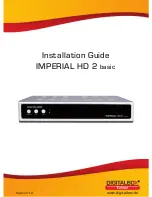
106
The System Setup and Other Setup menus
12
Making receiver settings from the System Setup menu
The following section describes how to change the speaker-related settings manually and make various other
settings (input selection, OSD language selection, etc.).
!
With factory default settings, the on-screen display will be output from all HDMI output terminals and
displayed on any TV connected via HDMI cable. You can change where the screen is output in the
MAIN/HDZONE
(
page 112
) and HDMI output (
page 86
) settings.
1 Press
u
STANDBY/ON to switch on the receiver and your TV.
Make sure that the TV’s video input is set to this receiver.
2 Press MAIN RECEIVER to switch the remote control to the receiver operation mode, and
then press HOME MENU.
A Graphical User Interface (GUI) screen appears on your TV. Use
i
/
j
/
k
/
l
and
ENTER
to navigate through the
screens and select menu items. Press
RETURN
to exit the current menu.
!
Press
HOME MENU
at any time to exit the
HOME MENU
.
3 Select ‘System Setup’ from the HOME MENU, then press ENTER.
4 Select the setting you want to adjust.
!
Manual SP Setup
– Sets the type of connection used for surround back terminals and the size, number dis-
tance and overall balance of the connected speakers (see
Manual speaker setup
on
page 106
).
!
Input Setup
– Specifies what you’ve connected to the digital, HDMI and component video inputs (see
The
Input Setup menu
on
page 52
).
!
OSD Language
– The GUI screen’s display language can be changed (see
Changing the OSD display lan-
guage (OSD Language)
on
page 54
).
!
Network Setup
– Conducts the setup necessary to connect this unit to the network (see
Network Setup
menu
on
page 108
).
!
HDMI Setup
– Synchronizes this receiver with your Pioneer component supporting
Control
with HDMI (
page
76
).
!
MHL Setup
– Changes the settings related to MHL (see
MHL Setup
on
page 110
).
!
Other Setup
– Makes customized settings to reflect how you are using the receiver (see
The Other Setup
menu
on
page 110
).
Manual speaker setup
This receiver allows you to make detailed settings to optimize the surround sound performance. You only need
to make these settings once (unless you change the placement of your current speaker system or add new
speakers).
These settings are designed to customize your system, but if you’re satisfied with the settings made in
Automatically conducting optimum sound tuning (Full Auto MCACC)
on
page 51
, it isn’t necessary to make all
of these settings.
CAUTION
!
The test tones used in the
Manual SP Setup
are output at high volume.
1 Select ‘Manual SP Setup’, then press ENTER.
See
Making receiver settings from the System Setup menu
on
page 106
if you’re not already at this screen.
2 Select the setting you want to adjust.
If you are doing this for the first time, you may want to adjust these settings in order:
!
Speaker System
– Specifies how you are using your surround back speaker terminals and B speaker termi-
nals (
page 106
).
!
Speaker Setting
– Specifies the size and number of speakers you’ve connected (
page 107
).
!
Channel Level
– Adjusts the overall balance of your speaker system (
page 108
).
!
Speaker Distance
– Specifies the distance of your speakers from the listening position (
page 108
).
!
X-Curve
– Adjusts the tonal balance of your speaker system for movie soundtracks (
page 108
).
3 Make the adjustments necessary for each setting, pressing RETURN to confirm after each
screen.
Speaker system setting
!
Default setting:
7.2.2ch TMd/FW
There are several ways you can use the speaker terminals with this receiver. In addition to a normal home theater
setup where they are used for the top middle speakers or front wide speakers, they can be used for bi-amping the
front speakers or as an independent speaker system in another room.
1 Select ‘Speaker System’ from the Manual SP Setup menu.
See
Making receiver settings from the System Setup menu
on
page 106
if you’re not already at this screen.
2 Select the speaker system setting.
!
7.2.2ch TMd/FW
– Select for normal home theater use with top middle and front wide speakers in your main
(speaker system A) setup.
!
7.2.2ch TMd/FH
– Select for normal home theater use with top middle and front height speakers in your
main (speaker system A) setup.
!
5.2.4ch
– Select for normal home theater use with top forward and top backward speakers in your main
(speaker system A) setup.
!
7.2ch + Speaker B
– Select to use the B speaker terminals to listen to stereo playback in another room (see
Switching the speaker terminals
on
page 85
).
!
7.2ch + Front Bi-Amp
– Select this setting if you’re bi-amping your front speakers (see
Bi-amping your speak-
ers
on
page 26
).
!
7.2ch + HDZONE
– Select to use the front wide speaker terminals for an independent system in another zone
(see
Using the MULTI-ZONE controls
on
page 87
).
!
5.2 Bi-Amp+HDZONE
– Select this to use the surround back speaker terminals for an independent system in
another zone with the front speakers bi-amped (see
Bi-amping your speakers
on
page 26
).
!
5.2 +ZONE 2+ZONE 3
– Select to use the surround back (ZONE 2) and front wide (ZONE 3) speaker terminals
for an independent systems in another zone (see
Using the MULTI-ZONE controls
on
page 87
).
!
5.2 +ZONE 2+HDZONE
– Select to use the surround back (ZONE 2) and front wide (HDZONE) speaker termi-
nals for an independent systems in another zone (see
Using the MULTI-ZONE controls
on
page 87
).
!
5.2ch + SP-B Bi-Amp
– Select this setting if you’re bi-amping your B speakers (see
Bi-amping your speakers
on
page 26
).
!
5.2ch F+Surr Bi-Amp
– Select this setting if you’re bi-amping your front and surround speakers (see
Bi-amping your speakers
on
page 26
).
!
5.2ch F+C Bi-Amp
– Select this setting if you’re bi-amping your front and center speakers (see
Bi-amping
your speakers
on
page 26
).
!
5.2ch C+Surr Bi-Amp
– Select this setting if you’re bi-amping your center and surround speakers (see
Bi-amping your speakers
on
page 26
).
!
Multi-ZONE Music
– See
Using Multi-ZONE Music
on
page 107
.
3 If you selected 7.2.2ch TMd/FW, 7.2.2ch TMd/FH, 7.2ch + Speaker B, 7.2ch + Front Bi-Amp,
or 7.2ch + HDZONE in Step 2, select the placement of the surround speakers.
In a 7.2-channel surround system with surround speakers placed directly at the sides of the listening position,
the surround sound of 5.1-channel sources is heard from the side. This function mixes the sound of the surround
speakers with the surround back speakers so that the surround sound is heard from diagonally to the rear as it
should be.
Summary of Contents for Elite SC-87
Page 1: ...Operating Instructions AV Receiver SC 87 SC 89 ...
Page 13: ...13 Remote control 14 Display 16 Front panel 17 Controls and displays ...
Page 142: ...Dolby Atmos Home Theater Installation Guidelines September 2014 ...
Page 157: ... 16 Figure 8 Standard 5 1 2 setup with overhead speakers ...
Page 158: ... 17 Figure 9 Standard 5 1 2 setup with Dolby Atmos enabled speakers ...
Page 159: ... 18 Figure 10 Standard 5 1 4 setup with overhead speakers ...
Page 160: ... 19 Figure 11 Standard 5 1 4 setup with Dolby Atmos enabled speakers ...
Page 161: ... 20 Figure 12 Standard 7 1 2 setup with overhead speakers ...
Page 162: ... 21 Figure 13 Standard 7 1 2 setup with Dolby Atmos enabled speakers ...
Page 163: ... 22 Figure 14 Standard 7 1 4 setup with overhead speakers ...
Page 164: ... 23 Figure 15 Standard 7 1 4 setup with Dolby Atmos enabled speakers ...
Page 165: ... 24 Figure 16 Standard 9 1 2 setup with overhead speakers ...
Page 166: ... 25 Figure 17 Standard 9 1 2 setup with Dolby Atmos enabled speakers ...
Page 188: ......
















































